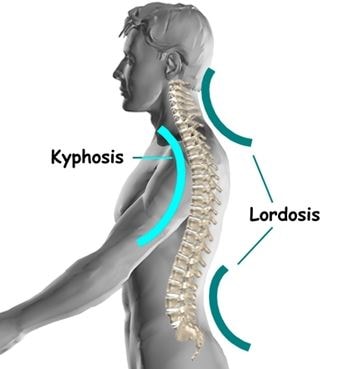Lumbar Lordosis
What is Lumbar lordosis?
In human anatomy, normally the spine automatically bend at the lower back, upper back and neck for taking the shock and bear the weight of the head. The medical term Lumbar lordosis commonly known as ‘swayback’ or “flat-back syndrome”. In this condition, the lower region of the spine, where five lumbar bones are present has extreme curvature. The resultant of this condition is failure to stand straight.

Image 1 – Observe C shaped curvature at lumbar region
Causes
The presence of lordosis provides prominence of buttocks. The significant presence of lordosis can be observed when individual lie down on the base of spine on a flat and hard surface. The large space gap occurs underneath the lower back.
- Benign juvenile lordosis is the condition where more prominent lordosis occurs in children, but this deformity is corrected naturally with increasing of age.
- Spondylolisthesis can also cause lordosis. In this condition, vertebral bone slides from its proper position and shifted onto the lower vertebral bone.
- In some cases, congenital deformity is one of the reasons of lumbar lordosis.
- Excessive sports activities, especially in case of gymnastic performances cause lordosis.
- Extreme arthritis also causes lordosis.
- Calcium deficiency which leads to osteoporosis is another reason of the development of lordosis
- Bone cancer or osteosarcoma may cause lordosis
- Increasing BMI, more than 30 is one of the symptoms of obesity and leads to lordosis.
Rare causes which can develop lordosis in children are
- Achondroplasia is the condition associated with disorder of bone development and resultant of dwarfism.
- Genetic reason
- Muscular dystrophies
Loss of lorodosis
The following conditions are responsible for loss of lordosis:
- The complication arises after scoliosis surgery may cause lumbar lordosis. Distraction surgical instrumentation pull out into the lower lumbar spine or sacrum is one of the commonly notorious aspects accountable for loss of lordosis.
- The other aggravated aspects which also trigger the loss of lordosis are thoracolumbar kyphosis, hip flexion contractures, fixed thoracic kyphosis and pseudoarthrosis.
Symptoms of Lumbar lordosis
Depending upon the severity of the disease, lordosis symptoms include:
- The buttocks are prominent with pronounced C-shaped spine curvature.
- The gap between the lower back and the flat surface is much more in lying down position
- Pain in the lower back
- Difficulty in standing straight
- Trouble in specific movements.
Diagnosis
The basic diagnosis of lumbar lordosis is initiated by physical examination. Usually doctors check the forward bending posture, side bending posture, and lie down posture on a flat surface, to examine the spine at different positions. If the flexibility of the lordotic curve is maintained properly, then it does not create any health issue, but the immobility of the curve needs proper medical treatment according to the underlying cause.

Image 2 – Differentiation of lumbar lordosis, thoracic kyphosis
For determining the underlying cause, the following tests are conducted:
- X-ray of the vertebral column: Radiographic measurement to evaluate the sagittal plane balance.
- Lumbosacral spine X-ray for C7-S1 measurement
- MRI of the vertebral column
- Laboratory tests which include different blood test.
Treatment
Usually mild lumbar lordosis not required any treatment, as it does not create any trouble. But in severe cases, doctors may recommend wearing a back brace and even surgical intervention.
Following treatment options are mainly followed in case of lumbar lordosis, depending upon the severity:
- Analgesic for lessening the pain syndrome and anti-inflammatory for inflammation.
- For improvement of muscular strength and flexibility, exercise and physiotherapy is beneficial.
- Support provided by wearing back brace
- Controlling BMI by reducing the weight
- Surgical intervention
Other than these available treatment options, the following measures are beneficial for lumbar lordosis.
- Physical therapy including electrical stimulation
- Vitamin D supplementation
Some exercises are beneficial for lessen the discomfort this include:
- Bend the neck, forward and backward direction and also side by side for 5 to 10 times a day
- Hip stretching exercise, the stretching of hip muscles hod for 15 seconds and then relax the muscle.
- Stretching of upper body parts: Regular slumping of the shoulder joint is also beneficial for lumbar lordosis.
- Lying down on a flat surface and gently pushing the back of the neck downwards and then raise the neck from the surface about an inch. Hold the position for 5 seconds and then relax.

Image 3 – Exercises for lumbar lordosis
References
- https://www.nlm.nih.gov/medlineplus/ency/article/003278.htm
- Loss of lumbar lordosis. A complication of spinal fusion for scoliosis. at http://www.ncbi.nlm.nih.gov/pubmed/3282206
- http://www.healthline.com/symptom/lordosis
- Lordosis: Causes, Symptoms, Diagnosis, Treatment & Exercises Overview at http://www.spinabifida.net/lordosis-causes-symptoms-diagnosis-treatment-exercises.html
- http://www.webmd.com/back-pain/guide/types-of-spine-curvature-disorders?page=2
